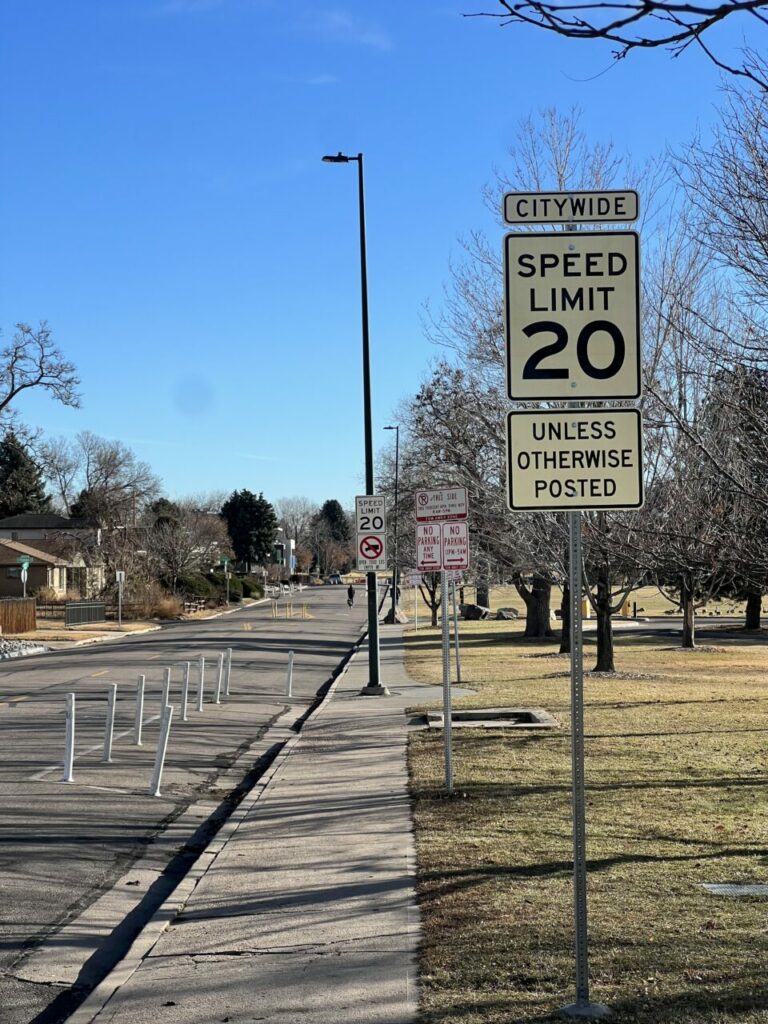By Allen Cowgill
In December 2021, Denver City Council passed a law to lower Denver’s default speed limit to 20 mph.

New speed limit signs have shown up in earnest in Denver neighborhoods over the last few months. On Jan. 9, at the monthly Department of Transportation and Infrastructure (DOTI) Advisory Board meeting, Mike King, principal city planner for the department, shared that over 3,000 new signs have been installed, with approximately 1,000 to go. Installation of the signs could be complete by the end of 2024.
The signs, intended to make the new residential speed limit clear to residents and anyone entering the city, are being installed on major roads where drivers enter the city and county of Denver and along streets that serve as entrances to neighborhoods.
The 20 mph speed limit applies to residential roads, the neighborhood streets without lane markings, and it is the default city speed limit. The new 20 mph speed limit does not apply to large collector and arterial roads, such as Federal Boulevard and West 38th Avenue, which will continue to have their own designated speed limits.
DOTI has 20 mph yard signs available through community groups and City Council offices. Residents can install them in their front yard to remind neighbors of the new speed limit.
The “20 is Plenty” movement – a push to reduce speed limits to 20 mph – has picked up steam in recent years, with the United Nations endorsing the limit recommendation in areas where people and motor vehicles mix. Internationally, countries including Scotland and Wales adopted 20 mph as a default speed limit on certain residential streets in 2023.
In the U.S., cities like Portland, Minneapolis, Seattle and Washington, D.C., have passed similar laws in the last few years. More locally, Boulder and Golden have also adopted 20 mph speed limits on residential streets.
“A pedestrian has a 13% likelihood of a severe injury or fatality if struck by a vehicle traveling 20 mph. That chance jumps to 40% if the vehicle is going 30 mph,” said Jill Locantore, executive director of local nonprofit Denver Streets Partnership, during the 20 is Plenty campaign that led to Denver’s new baseline speed limit.
An international advocacy organization based in the United Kingdom, 20 is Plenty for Us, asserts that the lower speed also widens drivers’ fields of vision and cuts the stopping distance for drivers in half, compared to when a driver is going 30 mph.
Recent studies out of Boulder and Portland have shown mixed results on whether 20 mph signage reduces driver speeds. A study by Portland State University showed that the median speed of drivers on residential streets didn’t change by much. But in the months after new signs went up, there was a reduction in speeding by some of the worst offenders, those who were excessively speeding more than 10 mph over the limit. In Boulder, researchers found that street design often had a bigger impact on vehicle speeds than the speed limit. They found that drivers went more slowly on narrow residential streets, and traveled at higher speeds on wider streets.
Allen Cowgill is the City Council District 1 appointee to the DOTI Advisory Board, where he serves as the board co-chair.

Be the first to comment